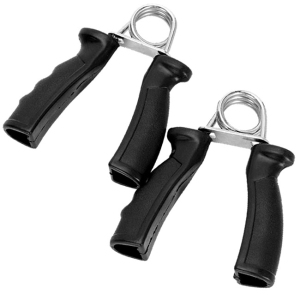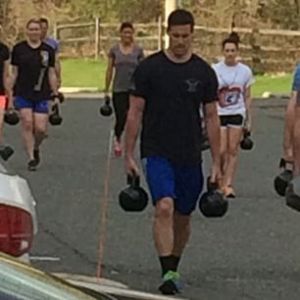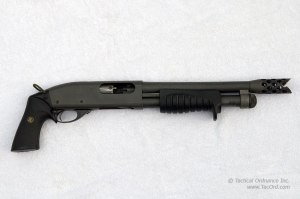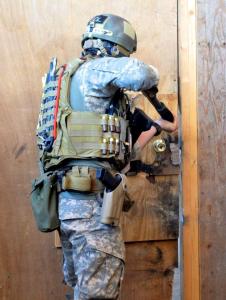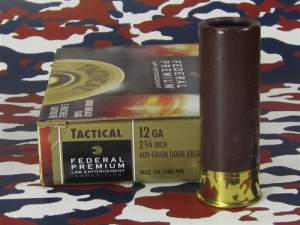One of the first articles I had done was on the short-comings of the shotgun and why it kinda sucks. Now we get the good stuff. Why I chose the shotgun, and specifically its most redeeming characteristics.

It’s hard to beat a classic.
It’s not tactical!!! While this is steadily changing, most off the rack shotguns look as they have for the better part of a century. With the exception of the Saiga, and a few bastardized versions of the 870 and 500 series that are magazine fed, a shotgun looks like a shotgun. This is not only a breath of fresh air, but an advantage is a more hostile anti-gun climate. With the ever looming hassle of pending legislation and bans on “assault style weapons”, you’ll find the shotgun absent from these lists. I believe the Saiga was on one of these lists in 1994 at one point but am not sure of and legislation against it as of this writing. There are no scary parts on the shotgun. No flash hiders, barrel shrouds, ghost gun buttons or shoulder things that go up. The only thing less tactical than the lowly shotgun would be the good ole lever gun. (Stay tuned for that). The shotgun is much more socially acceptable.When I worked for the local court capturing bail jumpers, my first go to gun was my AK. This was when I was wet behind the ears, thought I was bullet proof and was gonna single handedly strike fear in the heart of all evil doers in my midst. I was quickly put in my place by an old sheriff deputy that would visit. “Boy, you come to my house with that thing, the last thing I think you’re there for is to do anything peacefully. Folks you’re going after are under enough stress already”. He was right. I quickly followed his example and got a shotgun.

Shotguns. Shotguns everywhere!!!
Omnipotence is another thing the shotgun has going for it. Regardless of what country you may go to, you will always find shotguns in racks, behind doors, in barns, and all over. Even in the most gun restrictive countries, i.e. UK and Australia, Side by Side and Over/Under shotguns are the order of the day as they are seen as sporting arms and not “weapons of destruction”. However, you can do serious business with that coach gun with a bit of proper training. So being a student of the scattergun can pay off in spades if you happen to find yourself in a bad way (Paris and Venezuela most recently) away from home.
Versatility with ammunition is a major defining factor. Given the design of the gun, there is a limitless flexibilty with the different types of ammunition that can be fired through it. I am speaking of the smooth bore varieties, and not the rifled barrels or slug guns. The most common types of ammunition being

- Birdshot: payload of small pellets, most are similar to BB’s, that will vary in size. These will be lead or steel, depending on local regulations. These are most commonly used, as stated in the name, for hunting game birds (quail, dove, partridge). There are some higher powered loads for shooting ducks and geese due to their being at great distances than the typical upland game bird. Also, there are loads made specifically for turkey. These tend to be higher power loads that produce a tighter than normal pattern. The reason behind this is because the turkey hunter is trying to hit the animal in the head/neck with as many pellets as possible in order to keep the breast and legs unscathed. Being that turkey are more difficult to hunt, these distance can be out to 40 yards and the patter must allow for maximum payload delivery on the point of aim.
- Buckshot: Round pellets ranging in size from .36 to .24 caliber in size. These are used for hunting larger game animals such as deer, boar, coyotes, and such. These are also my preferred home defense load. One pull of the trigger launches 8-9 9mm pellets into a bad guy. Thats really all it takes. I will get more in depth about ammunition selection at a later date
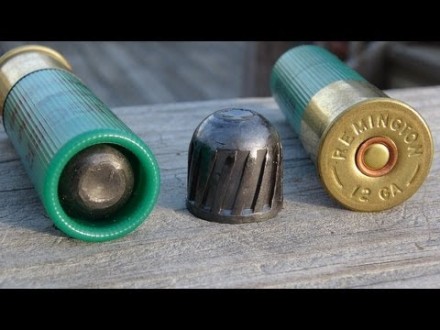
- Slugs: These are large, usually 1 ounce projectiles that are used to take down large game all over the world. Bears, moose, elk, boar, buffalo, cape buffalo, crocodiles, etc. These are also very effective on bad guys. However, with increased recoil, there is no margin for error.
Ammunition availability is a big deal as well. It seems that every year or two, usually around an election, there is an ammo drought. The shotgun ammo never seems to be effected by this.
A caliber/gauge for everyone in the family is helpful. The most common load is 12gauge. One step down is 20gauge. Most men are going to shoot 12ga as a manner of ammunition availability, and maybe a bit of machismo. Most ladies, with proper push/pull training, can handle a 12ga shotgun with defensive loads just fine. However, my mantra continues to be, if you’re good with a 12ga, then you can perform surgery with a 20ga. With the recoil reduced almost in half, it is a joy to shoot. Now, if only the ammunition in regards to buckshot and slug offerings would catch up, Id be over-joyed. For the kids, there is .410. This is measured in caliber, and not gauge. This shell is closer in size to a .45 Long colt and has minimal recoil.
Cost is King especially in this day and age. Your run of the mill AR is going to run you about $600. You can still get most off the shelf Remington 870’s and Mossberg 500’s for between $300-$400. I know the Mossberg Maverick 88’s typically run closer to $200.
Various Range use is another wonderful factor. Inside of the normal room, most of you shotgun loads are going to be lethal. With modern materials and technology, specifically Federal Premiums Flite Control Wad, buckshot can be used to great effect out to 50 yds. However, past 25 yds, you should really be thinking about switching to slugs to put effective hits on target. The shotgun is effective from room/hallway distance, out to the other side of a city block with the right ammunition.
Personalization of the gun to the shooter is a key in successful employment of the gun. While the shotgun is a pretty straight forward tool, there are a few tings on the market that you can add to them that give you a distinct advantage. There are a litany of sights, and stocks in order to fir the gun to a specific shooter and role. As far as defensive/offensive use, the Magpul stock set and the Rob Haught style of Scattergun Tech sights are a superb combination. However, the shotgun should be tailored to the shooter and the job at hand. Shop around and find what worked well for your size, and eyes, along with what you need the gun to do.
One Shot Fight Stopper is not something i say flippantly. The term “stopping power” is used so often that its become a joke. Mostly because it is used when referencing handguns. Often those in the .45ACP flavor. HANDGUNS DON’T HAVE STOPPING POWER. They just don’t. However, when you are across your bedroom and a lunatic breaks the door down, 1 shot, center mass, with a load of buckshot, or slug, will almost certainly drop the perpetrator in his/her tracks. The amount of trauma will be horrendous and chances are, there will be a significant amount of viscera to shovel off the floor and wall. Its just the way it is. The shotgun is the most devastating firearm the every day person can utilize. To quote Rob Haught “handguns put holes into people, rifles put holes through people, shotguns disassemble people”.
The shotgun can put food on the table and protect those you hold dear. I have carried one for work and still take one where ever I am. I don’t see this changing anytime soon. Its hard to beat the ole scattergun.


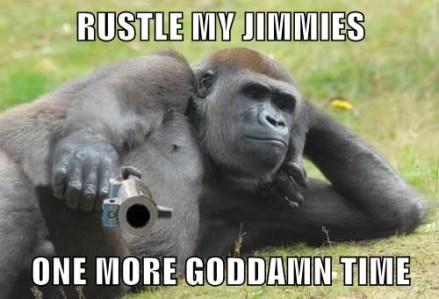





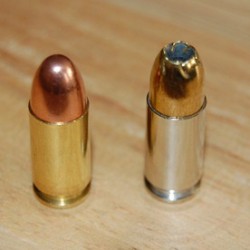
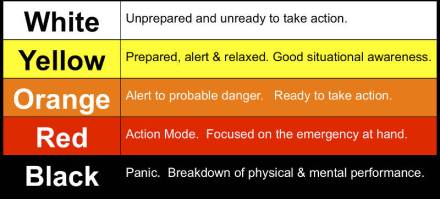
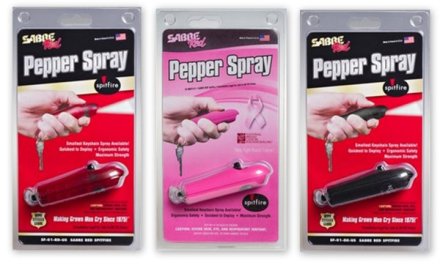
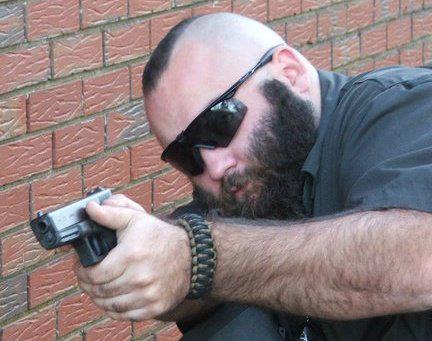 (a knife is also a lethal option but is a really nasty and complicated option that I don’t suggest unless there are no other options. KNIVES ARE NOT LESS-LETHAL OPTIONS). Once this happens, there are still more options. Just because you have pulled your gun DOES NOT mean you have to use it, but you should be prepared to. Simply yelling STOP!!!!!! while presenting the gun might very well solve the problem at hand. There are many different ways for the situation to go. You prepare for this by taking quality training and utilizing dryfire exercises. I suggest Claude Werner’s 1000 days of dryfire. As far as quality training, I would be happy to help anyone I can. I also would highly recommend Craig Douglas of ShivWorks, Paul Sharp and his MDOC system, Claude Werner, Tom Givens of Rangemaster, Clint Smith of Thunder Ranch, John Farnham of Defense Training International, Paul Howe, Steve Fisher of Sentinel Concepts, Jeff Bloovman of Armed Dynamics, Mark Luell of Growing Up Guns,(Super) Dave Harrington, Reid Heinrichs of Valor Ridge, Jeff Gonzalez of Trident Concepts, and the list goes on and on. I have trained with several of these folks and would gladly send my loved ones to them for quality, realistic, robust training to trust their lives with.
(a knife is also a lethal option but is a really nasty and complicated option that I don’t suggest unless there are no other options. KNIVES ARE NOT LESS-LETHAL OPTIONS). Once this happens, there are still more options. Just because you have pulled your gun DOES NOT mean you have to use it, but you should be prepared to. Simply yelling STOP!!!!!! while presenting the gun might very well solve the problem at hand. There are many different ways for the situation to go. You prepare for this by taking quality training and utilizing dryfire exercises. I suggest Claude Werner’s 1000 days of dryfire. As far as quality training, I would be happy to help anyone I can. I also would highly recommend Craig Douglas of ShivWorks, Paul Sharp and his MDOC system, Claude Werner, Tom Givens of Rangemaster, Clint Smith of Thunder Ranch, John Farnham of Defense Training International, Paul Howe, Steve Fisher of Sentinel Concepts, Jeff Bloovman of Armed Dynamics, Mark Luell of Growing Up Guns,(Super) Dave Harrington, Reid Heinrichs of Valor Ridge, Jeff Gonzalez of Trident Concepts, and the list goes on and on. I have trained with several of these folks and would gladly send my loved ones to them for quality, realistic, robust training to trust their lives with.